Reserve-Constrained Unit Commitment Considering Adjustable-Speed Pumped-Storage Hydropower and Its Economic Effect in Korean Power System
Abstract
:1. Introduction
1.1. Research Motivation
1.2. Related Research
1.3. Contribution
- An MIP-based RCUC problem was formulated. FS-PSH was modeled to provide the primary and secondary/regulation reserves in the generation mode, while AS-PHS was modeled to provide the primary and the secondary/regulation reserve both in the generating and pumping modes.
- A comparative analysis was performed on the Korean power system considering the generation mix in 2030 using the developed RCUC. The Korean power system is expected to consist of more than 200 large generators, including eighteen nuclear power generators with a capacity of 20.4 GW and a peak demand of 110 GW in 2030.
- The comparative study showed that the AS-PSH was superior to the FS-PSH in terms of operating costs, which are mainly dependent on the procurement of primary and secondary reserves. It is partly because the system is isolated and partly because the share of non-flexible nuclear power generators is high. We verified that the most critical factor is the capability of supplying the primary reserve.
2. Variable Renewable Energy in Future Korean Power System
2.1. Modeling of Variable Renewable Energy’s Output Power
2.1.1. Wind Energy Output Power Model
2.1.2. Solar Energy Output Power Model
2.2. Characteristics of Variable Renewable Energy in Korea
2.3. Influence of Variable Renewable Energy on Reserve Requirements of the Korean Power System
3. RCUC Considering Adjustable-Speed Pumped-Storage Hydropower
3.1. Flexibility of Adjustable-Speed Pumped-Storage Hydropower
- (1)
- AS-PSH can be operated over a wider operational range in the generating mode, and the input power can be controlled in the pumping mode.
- (2)
- AS-PSH can provide primary, secondary, and regulation reserves in the generating and pumping modes.
3.2. Objective Function to Minimize the Operating Cost of the Power System
3.3. Constraints Considering AS-PSH
3.3.1. Integer Variable Constraints
3.3.2. Load Balance Constraints
3.3.3. Power Limit Constraints
3.3.4. Minimum Uptime/Downtime Constraints
3.3.5. Generator Ramp-rate Constraints
3.3.6. Spinning Reserve Provision Constraints
3.3.7. Power Limit Constraints Considering Spinning Reserve
3.3.8. Spinning Reserve Requirement Constraints
3.3.9. Upper Reservoir of PSH Constraint
4. Simulation
4.1. Scenarios
4.2. Results
- (1)
- All of the available nuclear power generators are maintained in an online state for 24 h.
- (2)
- Nuclear power generators do not provide spinning reserves.
4.3. Discussion
5. Conclusions
- In the duck-curve environment with an increased spinning reserve requirement, it was difficult to operate nuclear power generators at their maximum capacities. In the results of Scenario A, the maximum available capacity of the nuclear power generators was 4.2 GW out of 16.4 GW.
- New PSH plants contributed to mitigating the duck-curve phenomenon and increased the maximum available capacity of the nuclear power generators, resulting in operating cost savings.
- The costs in Scenarios A, B, C, and D were KRW 43,129.38, 40,038.44, 39,354.92, and 34,030.46. The results were mainly derived from the provision of the primary reserve by AS-PSH’s pumping mode.
Author Contributions
Funding
Conflicts of Interest
Nomenclature
| GU | Set of all generating units |
| PP | Set of PSH units, PP ⊂ GU |
| AP | Set of AS-PSH units, AP ⊂ PP ⊂ GU |
| T | Operation period, index by t |
| i | Index for unit, i ∈ GU, PP, or AP |
| t | Index for time interval, t = 1, …, T |
| FCi(∙) | Fuel cost function of unit i at hour t $ |
| STCi | Startup cost of Unit i, $ |
| System load at Time t, MW | |
| Output of renewable energy sources at Time t, MW | |
| Minimum output power of Unit i, MW | |
| Maximum output power of Unit i, MW | |
| Minimum pumping input power of PSH plant i, MW | |
| Maximum pumping input power of PSH plant i, MW | |
| MUi | Minimum up-time of Unit i, hour |
| MDi | Minimum down-time of Unit i, hour |
| RUi | Up-ramping limit of Unit i, MW/minute |
| RDi | Down-ramping limit of Unit i, MW/minute |
| Ri | Droop of Unit i, p.u. |
| SFi | Operational limit deviation of system frequency, Hz |
| SFs | Standard system frequency, Hz |
| PRLU | Requirement of primary reserve respond to largest unit loss, MW |
| SRLU | Requirement of secondary reserve respond to largest unit loss, MW |
| Standard deviation of VRE’s 1 min variation | |
| Standard deviation of VRE’s 5 min variation | |
| Standard deviation of load’s 5 min variation | |
| EFFi | Pumping efficiency of PSH plant i |
| Maximum volume of upper reservoir of PSH plant i, MWh | |
| Maximum up-secondary and regulation reserve of unit i, MW | |
| Maximum up-secondary and regulation reserve of AS-PSH i (generating), MW | |
| Maximum up-secondary and regulation reserve of AS-PSH i (pumping), MW | |
| Maximum up-primary reserve of unit i, MW | |
| Maximum up-primary reserve of AS-PSH (generating) i, MW | |
| Maximum up-primary reserve of AS-PSH (pumping) i, MW | |
| Maximum down-secondary and regulation reserve of unit i, MW | |
| Maximum down-secondary and regulation reserve of AS-PSH i (generating), MW | |
| Maximum down-secondary and regulation reserve of AS-PSH i (pumping), MW | |
| Maximum down-primary reserve of unit i, MW | |
| Maximum down-primary reserve of AS-PSH (generating) i, MW | |
| Maximum down-primary reserve of AS-PSH (pumping) i, MW | |
| Up-primary reserve requirement at hour t, MW | |
| Down-primary reserve requirement at hour t, MW | |
| Up-secondary and regulation reserve requirement at hour t, MW | |
| Down- secondary and regulation reserve requirement at hour t, MW |
| ui,t | Integer variable for startup, 1 when off to on at hour t |
| di,t | Integer variable for shutdown, 1 when on to off at hour t |
| ii,t | Integer variable for on/off, on = 1/off = 0 at hour t |
| li,t | Integer variable for on/off (pumping mode of PSH), on = 1/off = 0 at hour t |
| Output of unit i at hour t, MW | |
| Pumping output of PSH plant i at hour t, MW | |
| Up-secondary and regulation reserve of unit i at hour t, MW | |
| Up-secondary and regulation reserve of AS-PSH (generating) i at hour t, MW | |
| Up-secondary and regulation reserve of AS-PSH (pumping) i at hour t, MW | |
| Up-primary reserve of unit i at hour t, MW. | |
| Up-primary reserve of AS PSH (generating) i at hour t, MW | |
| Up-primary reserve of AS PSH (pumping) i at hour t, MW | |
| Down-secondary and regulation reserve of unit i at hour t, MW | |
| Down-secondary and regulation reserve of AS-PSH (generating) i at hour t, MW | |
| Down-secondary and regulation reserve of AS-PSH (pumping) i at hour t, MW | |
| Down-primary reserve of AS-PSH (generating) i at hour t, MW | |
| Down-primary reserve of AS-PSH (pumping) i at hour t, MW | |
| Down-primary reserve of unit i at hour t, MW | |
| vi,t | Volume of PSH plant i at hour t |
| n | Index for a wind turbine in a wind farm, n = 1, 2, 3, …, N |
| PWT,n | Output power of nth wind turbine in a wind farm, MW |
| Pcurvefit | Polynomial function of output power for (Vin ≤ V ≤ Vr), MW |
| Pr | Rated output power of wind turbine, MW |
| Vin | Cut-in wind speed, m/s |
| Vr | Rated wind speed, m/s |
| Vout | Cut-out wind speed, m/s |
| PWF | Output power of wind farm, MW |
| CWF | Capacity of wind farm, MW |
| Vm | Wind speed at height Zm, m/s |
| Vh | Wind speed at height Zh, m/s |
| Zm | Height 1 (lower height, 10m), m |
| Zh | Height 2 (upper height, Tower hub height), m |
| α | Power-law exponent |
| PPV,M | Output power of PV module, W |
| Rated output power of PV module in STC, W | |
| G | Actual solar irradiance, W/m2 |
| G* | Solar irradiance in STC, 1000 W/m2 |
| γ | Module maximum power temperature coefficient, 1/°C |
| TC | PV module temperature, °C |
| PPV | Output power of PV power plant, MW |
| CPV | Capacity of PV power plant, MW |
| TA | Air temperature, °C |
| TNOCT | Nominal operating cell temperature, °C |
References
- Ministry of Trade, Industry and Energy of South Korea. The 9th Basic Plan for Long-Term Electricity Supply and Demand; Ministry of Trade Industry and Energy Republic of Korea: Sejong, Korea, 2020.
- Ela, E.; Milligan, M.; Kirby, B. Operating Reserves and Variable Generation; Technical Report; National Renewable Energy Laboratory: Golden, CO, USA, 2011. [Google Scholar] [CrossRef] [Green Version]
- California, ISO. Fast Fact, What the Duck Curve Tells us about Managing a Green Grid. 2016. Available online: https://www.caiso.com/Documents/FlexibleResourcesHelpRenewables_FastFacts.pdf (accessed on 29 October 2020).
- Kim, W.J.; Lee, Y.S.; Chun, Y.H. Assessment of Primary Control Reserve Requirement from Generator Considering a Battery Energy Storage System. J. Electr. Eng. Technol. 2020, 15, 315–324. [Google Scholar] [CrossRef]
- Koritarov, V.; Veselka, T.D.; Gasper, J.; Bethke, B.M.; Botterud, A.; Wang, J.; Mahalik, M.; Zhou, Z.; Milostan, C.; Feltes, J. Modeling and Analysis of Value of Advanced Pumped Storage Hydropower in the United States. Science 2014, 246, 25–31. [Google Scholar] [CrossRef]
- Pérez-Díaz, J.I.; Jiménez, J. Contribution of a Pumped-Storage Hydropower Plant to Reduce the Scheduling Costs of an Isolated Power System with High Wind Power Penetration. Energy 2016, 109, 92–104. [Google Scholar] [CrossRef] [Green Version]
- Al-Masri, H.M.K.; Al-Quraan, A.; AbuElrub, A.; Ehsani, M. Optimal Coordination of Wind Power and Pumped Hydro Energy Storage. Energies 2019, 12, 4387. [Google Scholar] [CrossRef] [Green Version]
- Bakhshaei, P.; Alireza, A.; Reza, A. Operation optimization of a grid-connected photovoltaic/pumped hydro storage considering demand response program by an improved crow search algorithm. J. Energy Storage 2021, 44, 103326. [Google Scholar] [CrossRef]
- Rahmati, I.; Foroud, A.A. Pumped-storage units to address spinning reserve concerns in the grids with high wind penetration. J. Energy Storage 2020, 31, 101612. [Google Scholar] [CrossRef]
- Alturki, F.A.; Awwad, E.M. Sizing and Cost Minimization of Standalone Hybrid WT/PV/Biomass/Pump-Hydro Storage-Based Energy Systems. Energies 2021, 14, 489. [Google Scholar] [CrossRef]
- Dianellou, A.; Christakopoulos, T.; Caralis, G.; Kotroni, V.; Lagouvardos, K.; Zervos, A. Is the Large-Scale Development of Wind-PV with Hydro-Pumped Storage Economically Feasible in Greece? Appl. Sci. 2021, 11, 2368. [Google Scholar] [CrossRef]
- Ma, Y.; Li, C.; Zhou, J.; Zhang, Y. Comprehensive stochastic optimal scheduling in residential micro energy grid considering pumped-storage unit and demand response. J. Energy Storage 2020, 32, 101968. [Google Scholar] [CrossRef]
- Nag, S.; Lee, K.Y. Network and Reserve Constrained Economic Analysis of Conventional, Adjustable-Speed and Ternary Pumped-Storage Hydropower. Energies 2020, 13, 4140. [Google Scholar] [CrossRef]
- Aburub, H.; Basnet, S.; Ward, T.J. On the use of adjustable-speed pumped hydro storage operation in the U.S. electricity market. J. Energy Storage 2019, 23, 495–503. [Google Scholar] [CrossRef]
- Feng, C.; Zheng, Y.; Li, C.; Mai, Z.; Wu, W.; Chen, H. Cost advantage of adjustable-speed pumped storage unit for daily operation in distributed hybrid system. Renew. Energy 2021, 176, 1–10. [Google Scholar] [CrossRef]
- Kazemi, M.; Siano, P.; Sarno, D.; Goudarzi, A. Evaluating the impact of sub-hourly unit commitment method on spinning reserve in presence of intermittent generators. Energy 2016, 113, 338–354. [Google Scholar] [CrossRef]
- Wu, J.; Luh, P.; Chen, Y.; Bragin, M.; Yan, B. A novel optimization approach for sub-hourly unit commitment with large numbers of units and virtual transactions. IEEE Trans. Power Syst. 2021. [Google Scholar] [CrossRef]
- Raghunathan, N.; Bragin, M.A.; Yan, B.; Luh, P.B.; Moslehi, K.; Feng, X.; Yu, Y.; Yu, C.-N.; Tsai, C.-C. Exploiting Soft Constraints within Decomposition and Coordination Methods for Sub-hourly Unit Commitment. Int. J. Electr. Power Energy Syst. 2022, 139, 108023. [Google Scholar] [CrossRef]
- Bragin, M.A.; Luh, P.B.; Yan, B.; Sun, X. A scalable solution methodology for mixed-integer linear programming problems arising in automation. IEEE Trans. Autom. Sci. Eng. 2018, 16, 531–541. [Google Scholar] [CrossRef]
- Yurdakul, O.; Sivrikaya, F.; Albayrak, S. Quantification of the Impact of GHG Emissions on Unit Commitment in Microgrids. In Proceedings of the IEEE/PES Transmission and Distribution Conference and Exposition: Latin America, Montevideo, Uruguay, 28 September 2020. [Google Scholar] [CrossRef]
- Nicolosi, F.F.; Alberizzi, J.C.; Caligiuri, C.; Renzi, M. Unit commitment optimization of a micro-grid with a MILP algorithm: Role of the emissions, bio-fuels and power generation technology. Energy Rep. 2021, 7, 8639–8651. [Google Scholar] [CrossRef]
- Korea Meteorological Administration. Available online: https://data.kma.go.kr/cmmn/main.do (accessed on 15 January 2020).
- Marčiukaitis, M.; Žutautaitė, I.; Martišauskas, L.; Jokšas, B.; Gecevičius, G.; Sfetsos, A. Non-Linear Regression Model for Wind Turbine Power Curve. Renew. Energy 2017, 113, 732–741. [Google Scholar] [CrossRef]
- Doosan Heavy Industries & Construction. Available online: https://www.doosanheavy.com/download/pdf/products/energy/DHI_Wind_Power_Brochure_Eng.pdf (accessed on 21 July 2021).
- Irwin, J.S. A Theoretical Variation of the Wind Profile Power-Law Exponent as a Function of Surface Roughness and stability. Atmos. Environ. 1979, 13, 191–194. [Google Scholar] [CrossRef]
- Cherenack, P. Conditions for Cubic Spline Interpolation on Triangular Elements. Comp. Math. Appl. 1984, 10, 235–244. [Google Scholar] [CrossRef] [Green Version]
- Osterwald, C.R. Translation of Device Performance Measurements to Reference Conditions. Solar Cells 1986, 18, 269–279. [Google Scholar] [CrossRef]
- Stultz, J.W. Thermal and Other Tests of Photovoltaic Modules Performed in Natural Sunlight. J. Energy 1979, 3, 363–372. [Google Scholar] [CrossRef] [Green Version]
- Billinton, R.; Allan, R.N. Operating reserve. In Reliability Evaluation of Power Systems, 2nd ed.; Springer: Boston, MA, 1996. [Google Scholar] [CrossRef]
- Korea Power Exchange 2021. The Rules and Regulation of Power Market Operation. Available online: https://www.kpx.or.kr/www/selectBbsNttList.do?bbsNo=114&key=29 (accessed on 19 November 2021).
- Holttinen, H. Impact of Hourly Wind Power Variations on the System Operation in the Nordic Countries. Wind. Energy 2005, 8, 197–218. [Google Scholar] [CrossRef]
- Holttinen, H.; Milligan, M.; Ela, E.; Menemenlis, N.; Dobschinski, J.; Rawn, B.; Bessa, R.J.; Flynn, D.; Gomez-Lazaro, E.; Detlefsen, N.K. Methodologies to Determine Operating Reserves Due to Increased Wind Power. IEEE Trans. Sustain. Energy 2012, 3, 713–723. [Google Scholar] [CrossRef]
- Tokyo Electric Power Company. Final Report on Feasibility Study on Adjustable Speed Pumped Storage Generation Technology; Japan International Cooperation Agency: Tokyo, Japan, 2012. Available online: https://openjicareport.jica.go.jp/643/643/643_000_12044822.html. (accessed on 6 January 2020).
- Takashi, F.; Hirotaka, T.; Hajime, K. Commencement of Commercial Operation of Kazunogawa Hydroelectric Power Station Unit 4 of Tokyo Electric Power Co., Inc. Employing World’s Largest Capacity Adjustable-Speed System. Toshiba Rev. 2015, 70, 7–10. Available online: https://www.global.toshiba/jp/technology/corporate/review/abstract/2015-01.html. (accessed on 24 August 2021).
- Kawabara, T.; Shibuya, A.; Furata, H.; Kita, E.; Mitsuhasi, K. Design and dynamic response characteristics of 400 MW adjustable speed pump storage built for Ohkawachi Power Station. IEEE Trans. Energy Convers. 1998, 11, 376–384. [Google Scholar] [CrossRef]
- Carrión, M.; Arroyo, J.M. A Computationally Efficient Mixed-Integer Linear Formulation for the Thermal Unit Commitment Problem. IEEE Trans. Power Syst. 2006, 21, 1371–1378. [Google Scholar] [CrossRef]
- Ostrowski, J.; Anjos, M.F.; Vannelli, A. Tight Mixed Integer Linear Programming Formulations for the Unit Commitment Problem. IEEE Trans. Power Syst. 2012, 27, 39–46. [Google Scholar] [CrossRef]
- Kundur, P. Control of active power and reactive power. In Power System Stability and Control; McGraw-Hill: New York, NY, USA, 1994. [Google Scholar]
- Park, M.-S.; Kim, W.-J.; Chun, Y.-H. Calculation of Primary Reserve Requirements Based on Measurements of Frequency Trajectories of Korean Power System. Trans. Korean Inst. Electr. Eng. 2019, 68, 399–404. [Google Scholar] [CrossRef]
- Corbus, D.; King, J.; Mousseau, T. Eastern Wind Integration and Transmission Study; US Department of Energy, National Renewable Energy Laboratory: Golden, CO, USA, 2010. Available online: https://www.energy.gov/eere/wind/downloads/eastern-wind-integration-and-transmission-study-ewits-revised. (accessed on 21 January 2022).
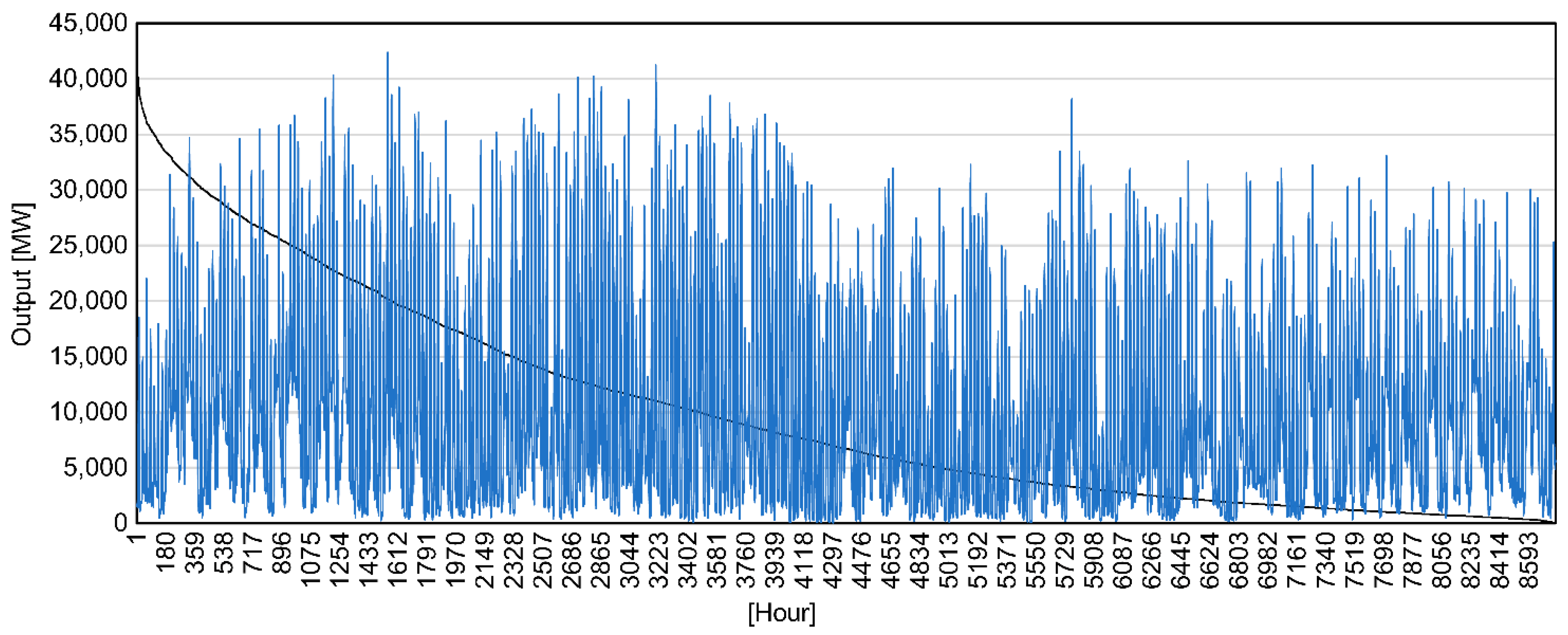
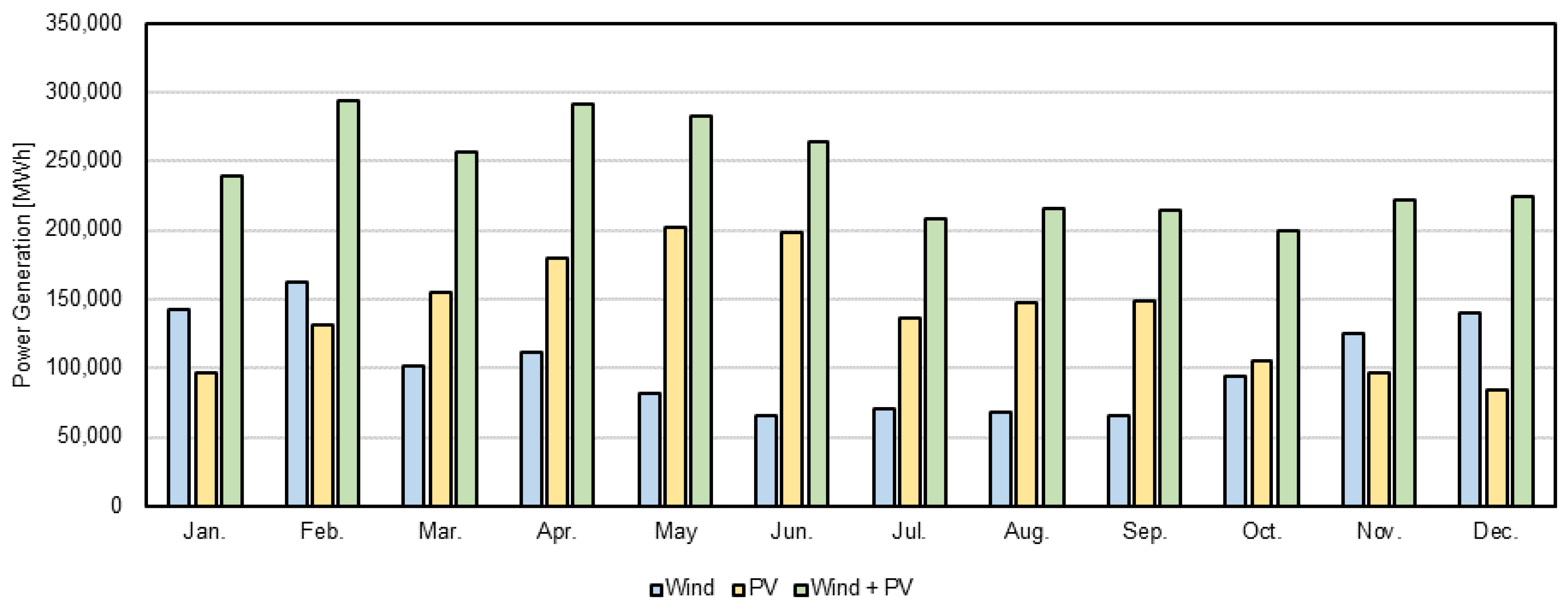


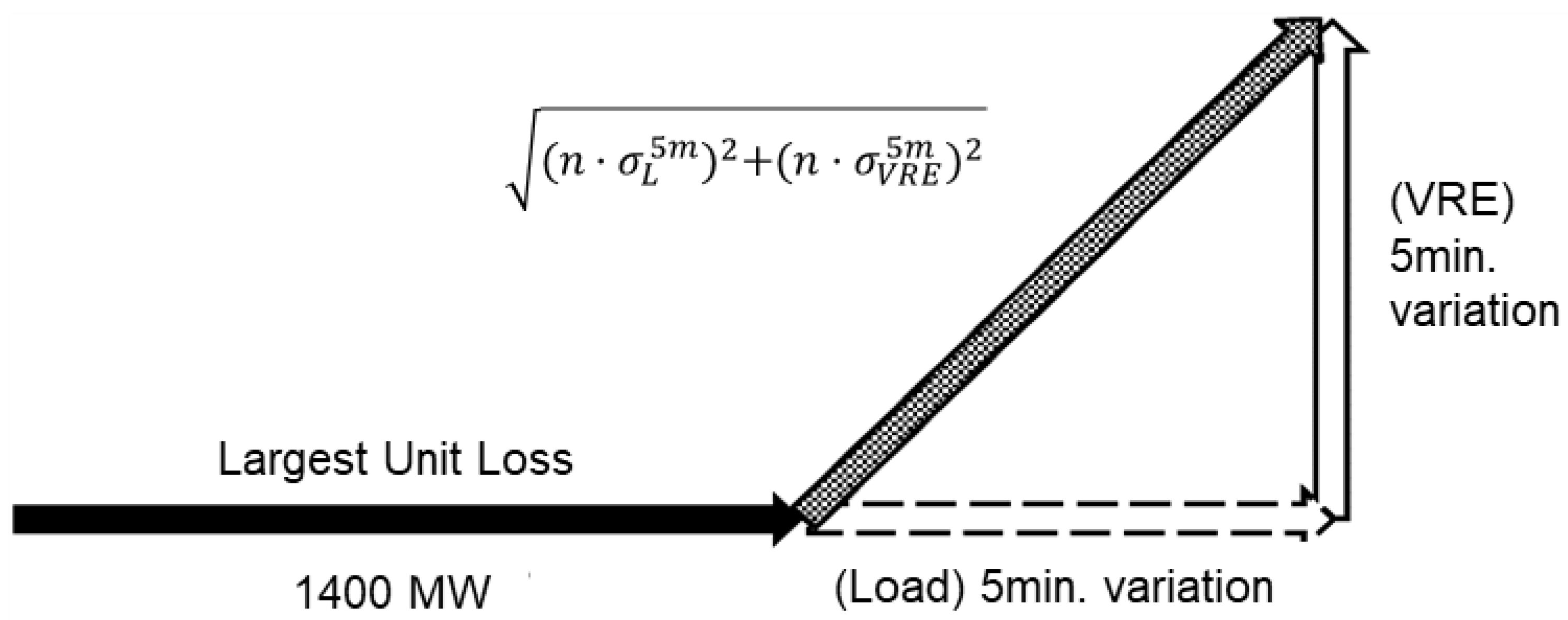
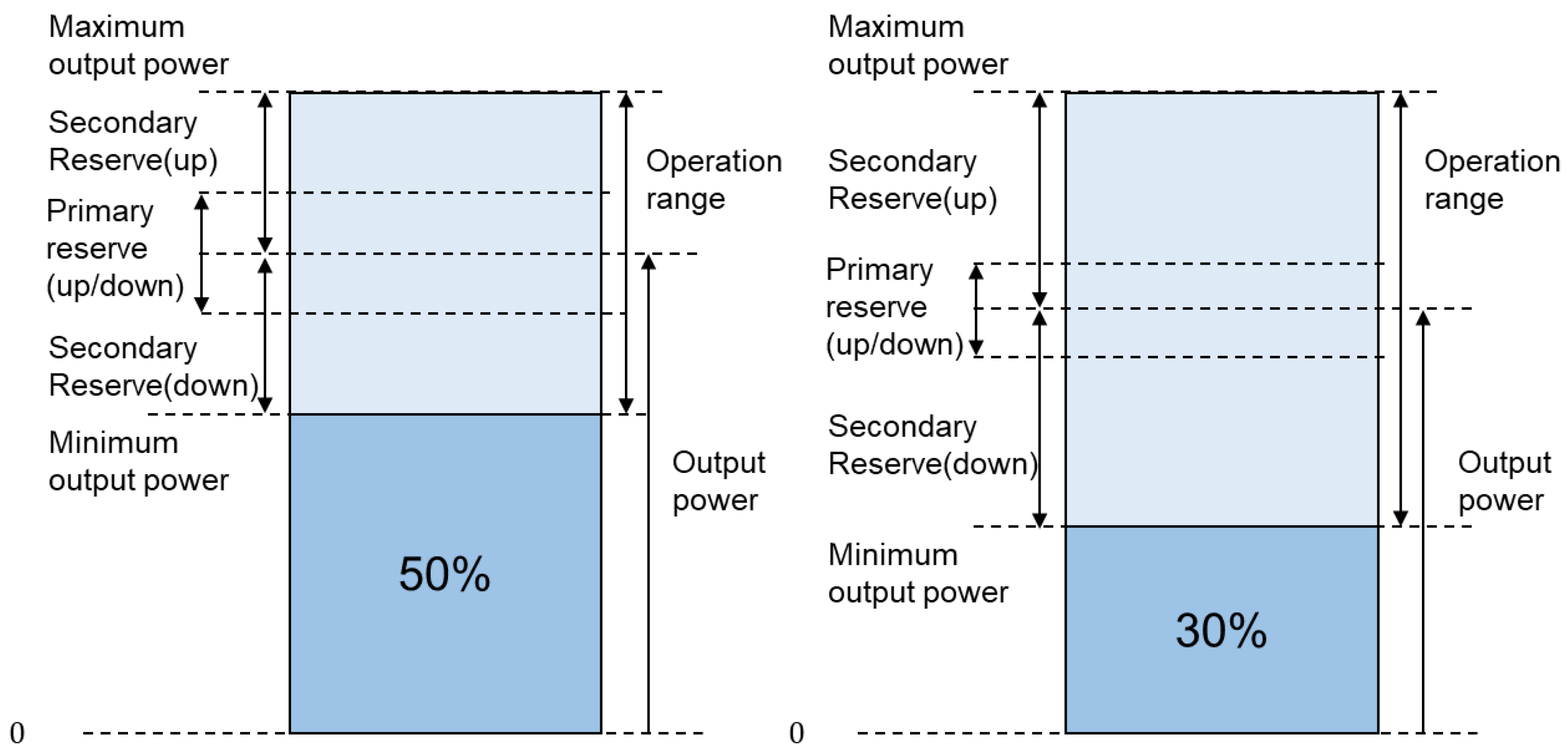

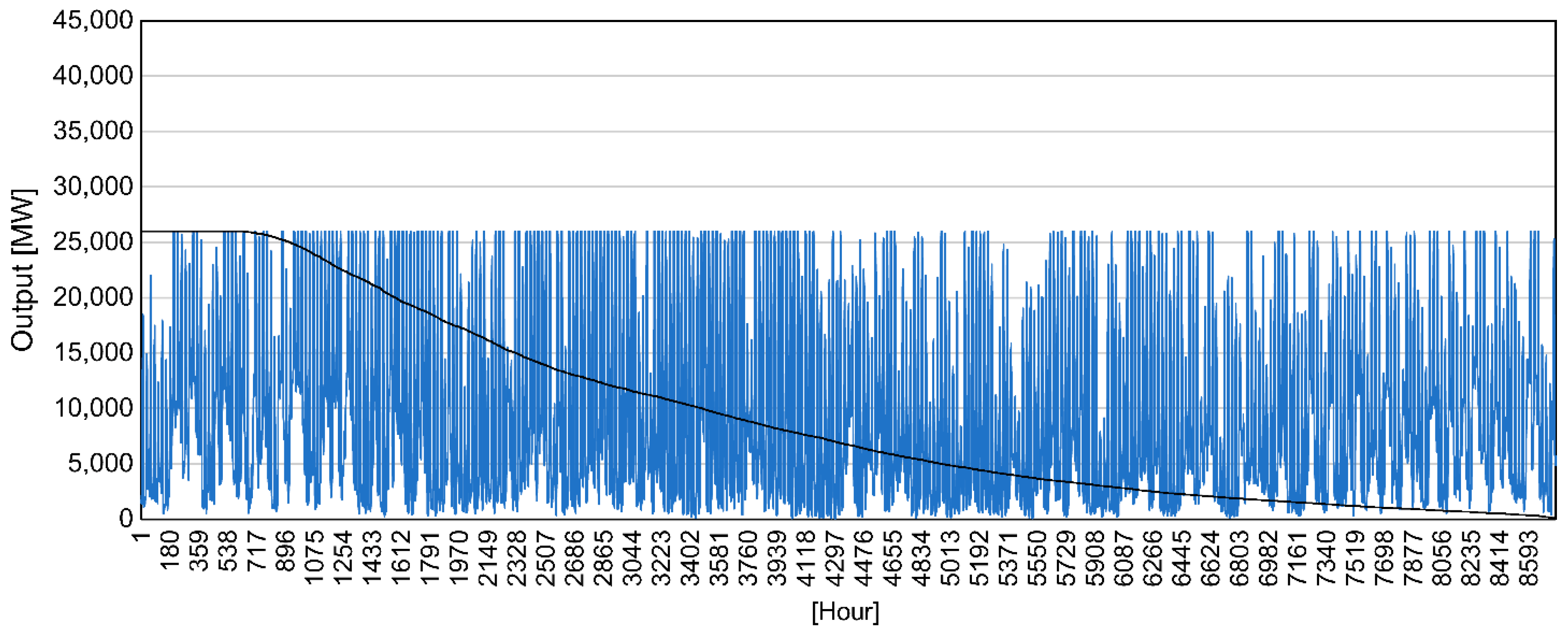
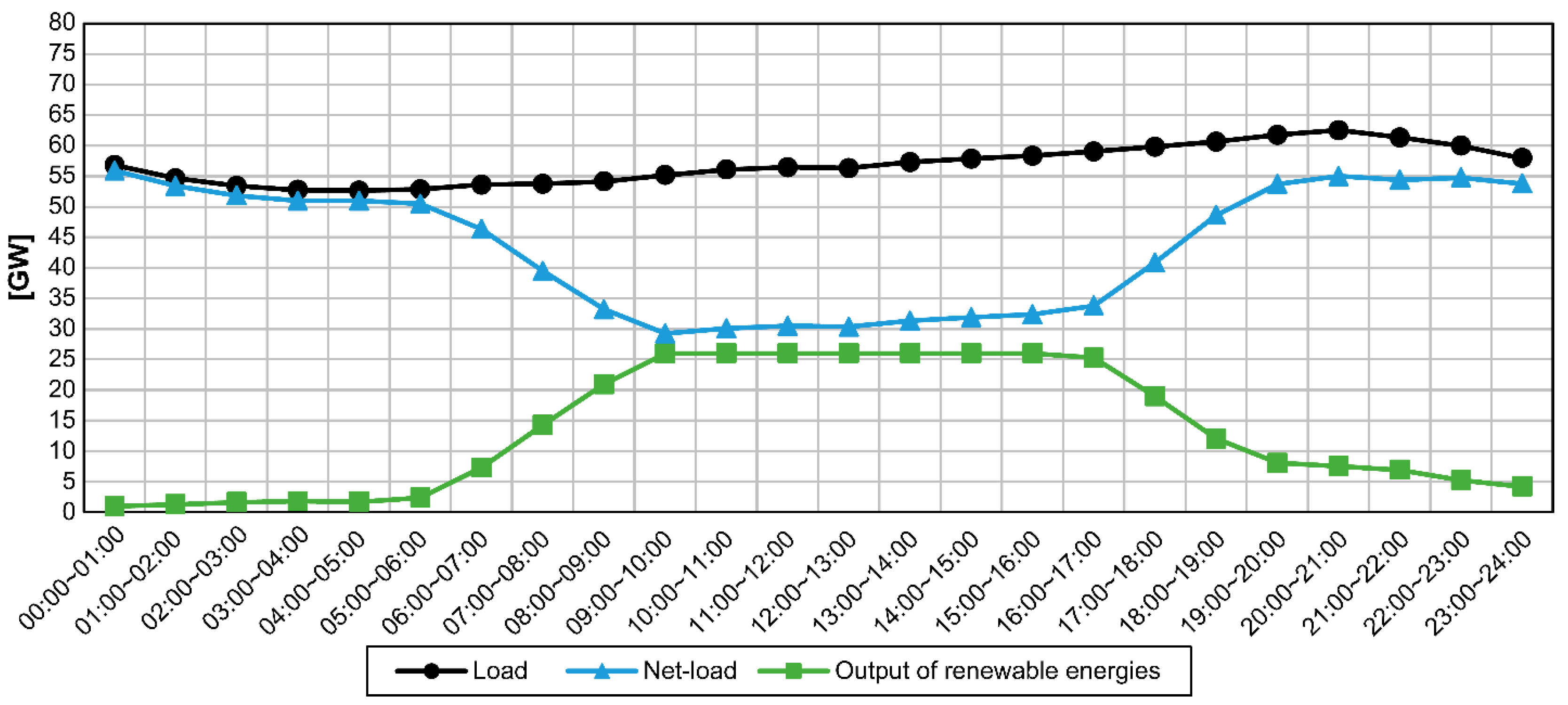
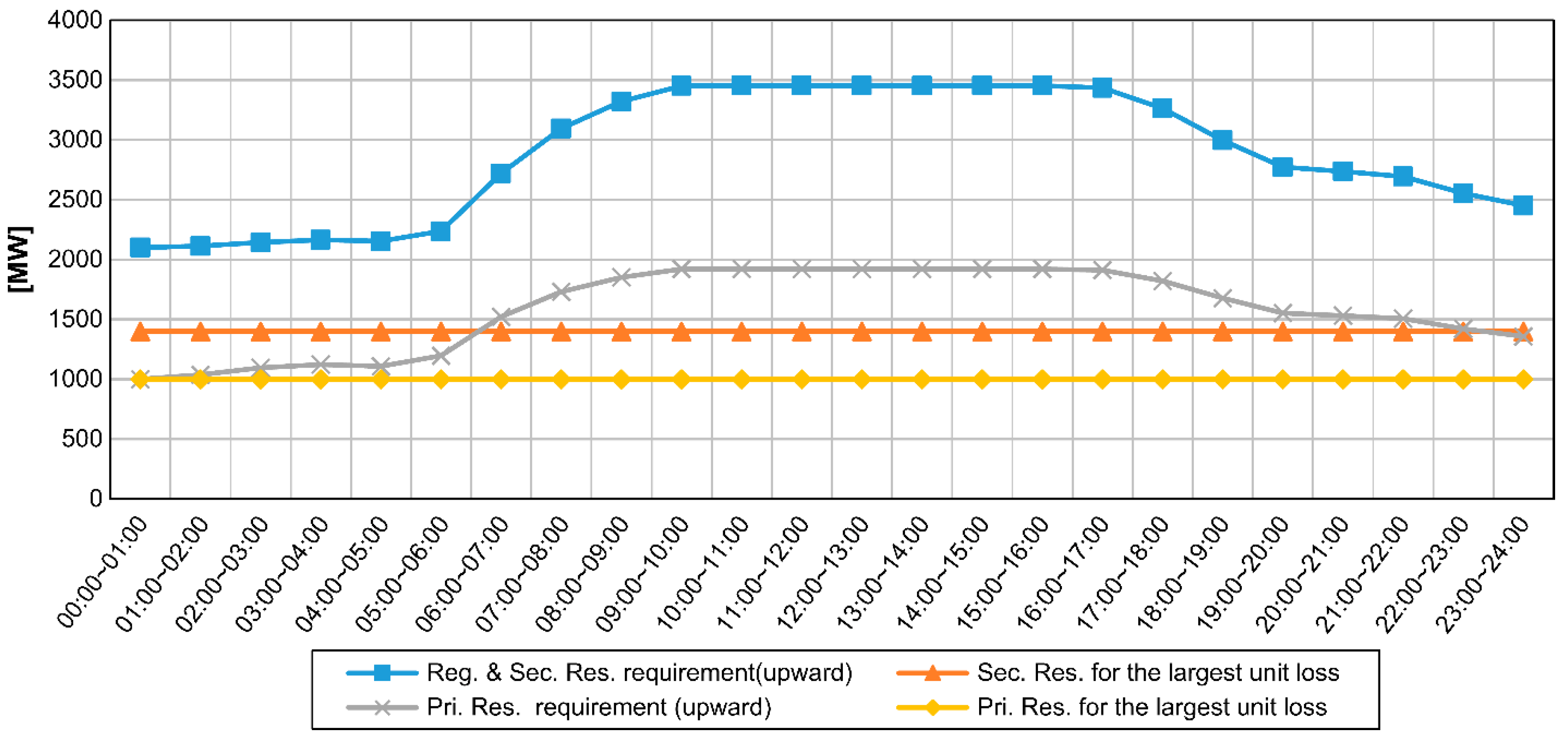
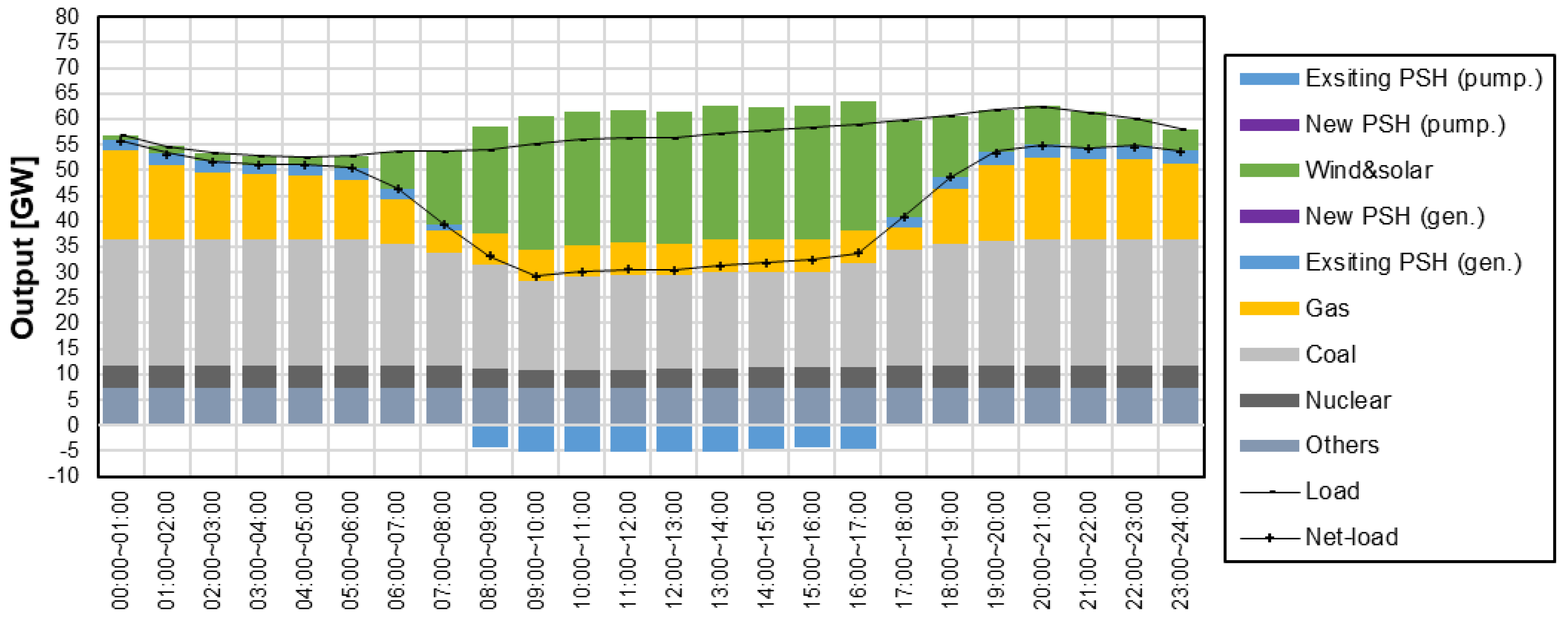
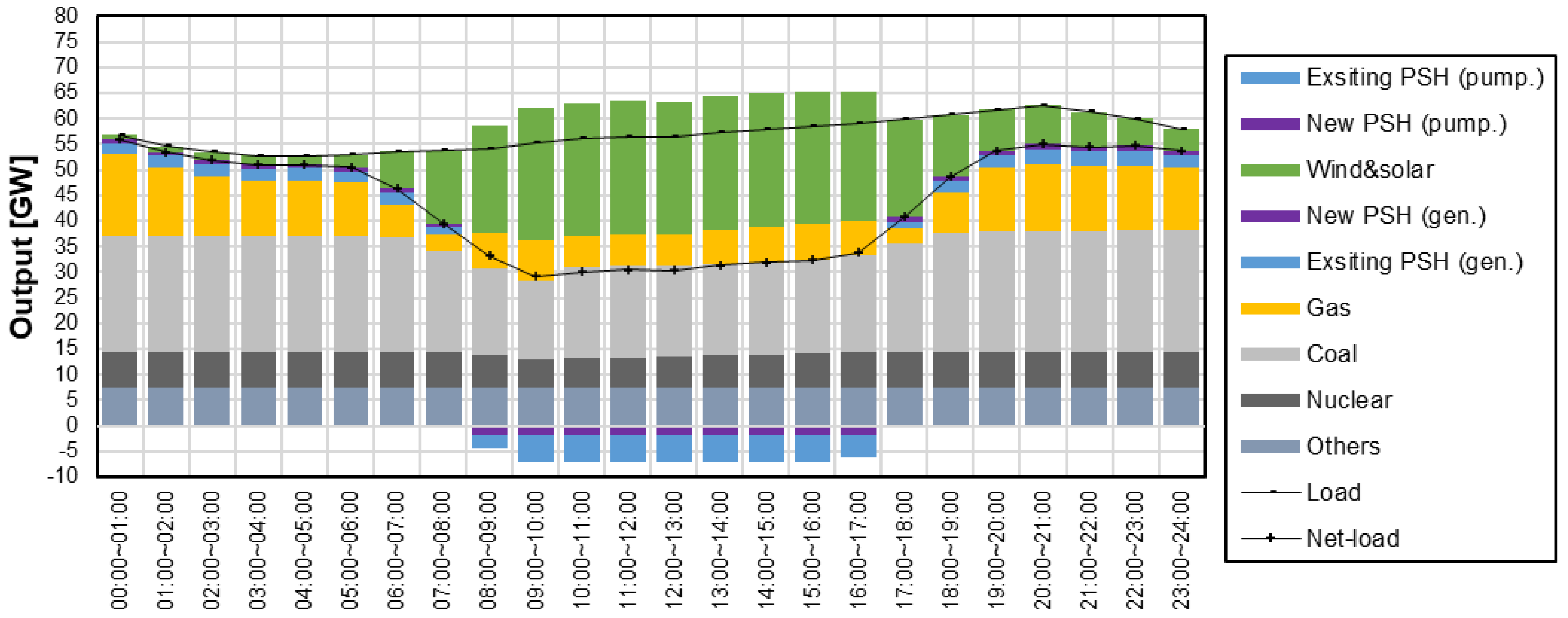
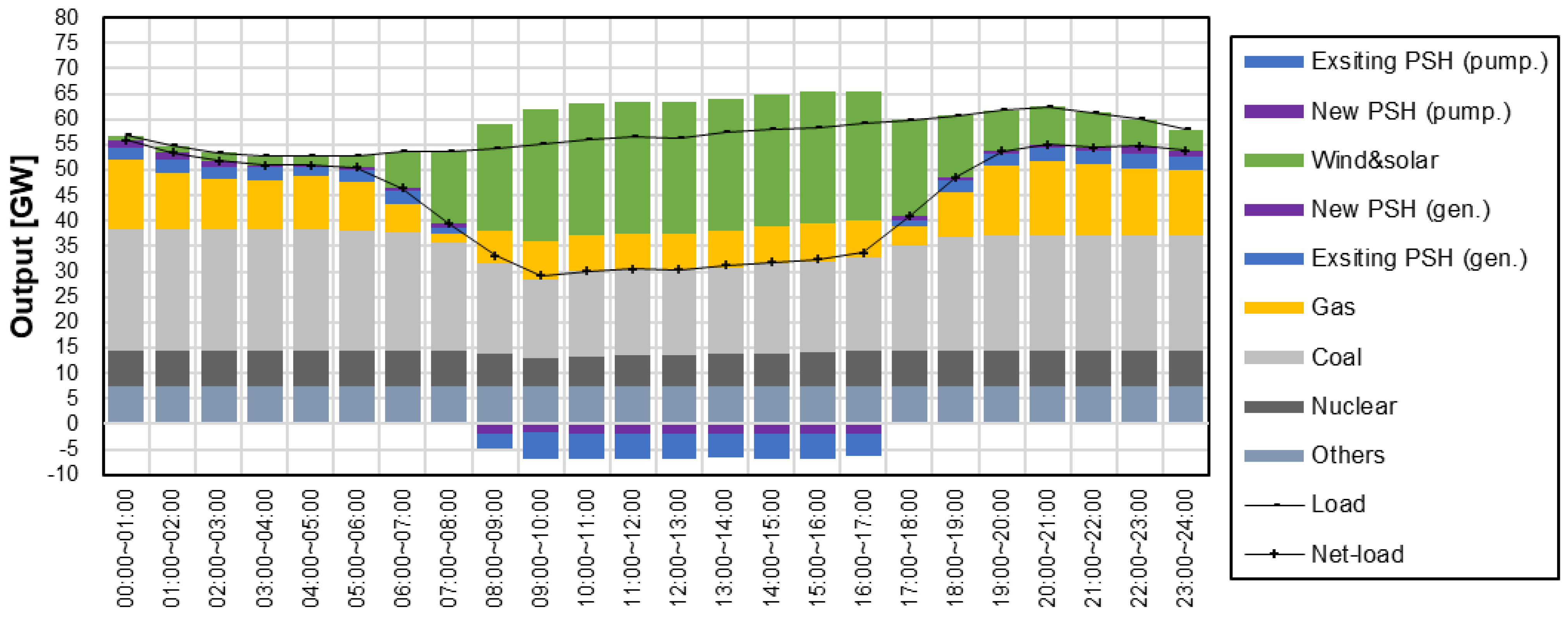


| Onshore | Offshore | |
|---|---|---|
| Rated power | 3 MW | 8 MW |
| Cut-in wind speed | 3 m/s | 3.5 m/s |
| Rated wind speed | 10 m/s | 10 m/s |
| Cut-out wind speed | 20 m/s | 25 m/s |
| Tower hub height | 120 m | 130 m |
| Operating Reserves | Requirement | State | Activated by | Secured for | |
|---|---|---|---|---|---|
| Regulation reserve | 700 MW | Spinning | AGC signal | Short-term load variation | |
| Frequency restoration reserves | Primary reserve | 1000 MW | Spinning | Governing system | Largest unit loss |
| Secondary reserve | 1400 MW | Spinning | AGC signal | Largest unit loss | |
| Tertiary reserve | 1400 MW | Standstill | Manual | Reserve restoration | |
| Quick-start reserve | 2000 MW | Standstill | Manual | Load forecast error, etc. | |
| Reserves | Activated by | Current Standard | Increments of Reserve |
|---|---|---|---|
| Primary reserve | Governing system | Largest unit loss | nσ of one-min. variation of wind and solar output |
| Secondary reserve | AGC signal | Largest unit loss | nσ of five-min. variation of wind and solar output |
| Regulation reserve | 3σ of five-min. variation of load |
| Operation Range | FS-PSH | AS-PSH | |
|---|---|---|---|
| Generating mode | Argonne Report [5] | 16–100% | 16~100% |
| JICA Report [33] | 30–100% | 30~100% | |
| Pumping mode | Argonne Report | 60–100% | 60~100% |
| JICA Report | 70–100% | 70~100% | |
| Operation Range | Max. Primary Reserve (Up/Downward) | Max. Secondary/Regulation Reserve (Up/Downward) | ||
|---|---|---|---|---|
| FS-PSH | Generating mode | 50~100% | 10% | 50% |
| Pumping mode | Constant at 100% | - | - | |
| AS-PSH | Generating mode | 30~100% | 10% | 70% |
| Pumping mode | 60~100% | 20% | 40% | |
| Scenario | Existing PSH Plants | New PSH Plants in 2030 | Total Capacity of PSH Plants, MW | |
|---|---|---|---|---|
| FS-Type, MW | FS-Type, MW | AS-Type, MW | ||
| A | 4700 | 0 | 0 | 4700 |
| B | 4700 | 600 × 3 = 1800 | 0 | 6500 |
| C | 4700 | 0 | 600 × 3 = 1800 | 6500 |
| D | 4700 | 0 | 600 × 3 = 1800 | 6500 |
| Scenario | Total Online Capacity of Nuclear Power Generators, GW | |||||||||||
|---|---|---|---|---|---|---|---|---|---|---|---|---|
| 16.4 | 15.4 | 14.4 | 13.4 | 12.4 | 11.4 | 10.4 | 9.4 | 8.4 | 7 | 5.6 | 4.2 | |
| A | Infeasible | Feasible | ||||||||||
| B | Infeasible | Feasible | ||||||||||
| C | Infeasible | Feasible | ||||||||||
| D | Infeasible | Feasible | ||||||||||
| Fuel-Type | Scenario A | Scenario B | Scenario C | Scenario D | ||||
|---|---|---|---|---|---|---|---|---|
| Cost, KRW | Share, % | Cost, KRW | Share, % | Cost, KRW | Share, % | Cost, KRW | Share, % | |
| Nuclear | 493.24 | 6.8 | 822.84 | 11.4 | 825.00 | 11.4 | 1,427.16 | 19.9 |
| Coal | 25,078.89 | 38.0 | 23,594.92 | 35.5 | 23,453.91 | 35.4 | 19,604.10 | 29.4 |
| Gas | 17,557.25 | 17.3 | 15,620.68 | 15.3 | 15,076.00 | 15.4 | 12,999.19 | 12.9 |
| Total costs | 43,129.38 | 62.1 | 40,038.44 | 62.2 | 39,354.92 | 62.2 | 34,030.46 | 62.2 |
Publisher’s Note: MDPI stays neutral with regard to jurisdictional claims in published maps and institutional affiliations. |
© 2022 by the authors. Licensee MDPI, Basel, Switzerland. This article is an open access article distributed under the terms and conditions of the Creative Commons Attribution (CC BY) license (https://creativecommons.org/licenses/by/4.0/).
Share and Cite
Kim, W.-J.; Lee, Y.-S.; Chun, Y.-H.; Jeong, H.-S. Reserve-Constrained Unit Commitment Considering Adjustable-Speed Pumped-Storage Hydropower and Its Economic Effect in Korean Power System. Energies 2022, 15, 2386. https://doi.org/10.3390/en15072386
Kim W-J, Lee Y-S, Chun Y-H, Jeong H-S. Reserve-Constrained Unit Commitment Considering Adjustable-Speed Pumped-Storage Hydropower and Its Economic Effect in Korean Power System. Energies. 2022; 15(7):2386. https://doi.org/10.3390/en15072386
Chicago/Turabian StyleKim, Woo-Jung, Yu-Seok Lee, Yeong-Han Chun, and Hae-Seong Jeong. 2022. "Reserve-Constrained Unit Commitment Considering Adjustable-Speed Pumped-Storage Hydropower and Its Economic Effect in Korean Power System" Energies 15, no. 7: 2386. https://doi.org/10.3390/en15072386
APA StyleKim, W.-J., Lee, Y.-S., Chun, Y.-H., & Jeong, H.-S. (2022). Reserve-Constrained Unit Commitment Considering Adjustable-Speed Pumped-Storage Hydropower and Its Economic Effect in Korean Power System. Energies, 15(7), 2386. https://doi.org/10.3390/en15072386






